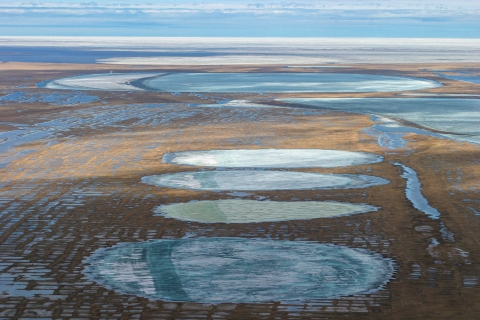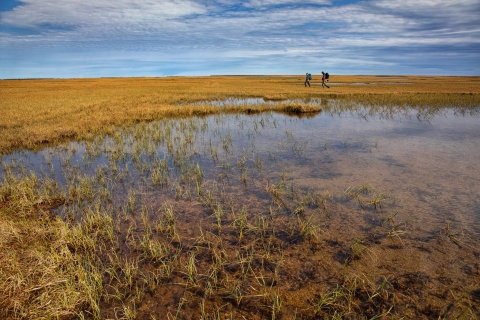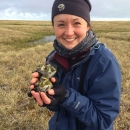Overview
Working together with Manomet, Inc., we conduct extensive shorebird surveys as part of the Program for Regional and International Shorebird Monitoring (PRISM) throughout the Arctic North Slope (focused in the Teshekpuk Lake Special Area [TLSA] in the National Petroleum Reserve – Alaska [NPR-A]), and in the past within the Yukon Delta National Wildlife Refuge. PRISM’s primary goal is to estimate the size of shorebird breeding populations in North America. This survey uses ground-based, plot survey methods that when analyzed can provide size and trends of shorebird populations. This survey also describes shorebird distribution and habitat relationships, can survey shorebirds during migration, assist managers in meeting their shorebird conservation goals, and provide data prior to proposed development, like oil and gas.
Teshekpuk Lake is the largest lake in Arctic Alaska. The TLSA in the NPR-A supports some of the highest densities of breeding shorebirds (and other arctic-nesting birds) in the North American Arctic. This area is critically important for birds and a diversity of other wildlife. Shorebirds are one of the largest and most threatened groups of birds on the Arctic Coastal Plain of Alaska. Migration surveys suggest shorebirds are declining throughout their ranges, but these surveys have low precision, and we need more accurate population estimates and trend information to guide management actions. Unlike waterfowl, breeding shorebirds cannot be counted by aerial surveys, and annual surveys on the ground of all or a large portion of northern North America would be prohibitively expensive. PRISM was created to address these challenges.
In addition to conducting PRISM surveys we are also testing methods for using automated recording units (ARUs) to record and detect birds within our survey plots, as a supplemental technique to monitoring shorebirds. PRISM survey data will provide the first comparison of changes in shorebird populations for the TLSA since 2008. These data will support both the range-wide population trend estimation goals of PRISM and provide important baseline data on shorebird status and trends before any proposed oil and gas exploration occurs. Updated population estimates for the TLSA will help target conservation actions both locally and range-wide if existing declines are confirmed (or new ones are detected) for shorebird species. In addition, the recording units will help determine if this emerging technology could be a cost effective and less invasive approach to surveying shorebirds in the future.
Importance of this Work
We know that many of our North American shorebird species are declining, but we don’t have a lot of information about their population sizes and trends. One of the few ways to determine how much a population is declining is to do surveys during the breeding season, when populations are fixed in space and time. Shorebirds are distributed over large landscapes in their breeding surveys, which can be difficult to access. To be successful, we must work collaboratively across their habitats to survey and monitor this imperiled group of birds. To accomplish this project, we rely on additional help and funding from federal grants and other organizations including non-profits, universities, and other agencies.
Actions WE ALL can take
Giving them Space. Beach/coastal walking, a seemingly harmless activity, can have negative consequences on shorebirds that are using the area for rest, foraging, or nesting. In some parts of the U.S., human disturbance is one of the most significant threats to shorebird populations. These threats can intensify as human use (coastal recreation, off-leash dogs) in these coastal areas increases, leading to an overall reduction in suitable, undisturbed habitats for shorebirds.
If you are recreating near a coastline, shoreline, or other wetland type used by shorebirds, please give the shorebirds space—ideally, do not approach within 200 m (656 ft.). If you are recreating with a dog, please keep your dog leased, as the presence of dogs is directly related to shorebirds expending more energy being alert to their presence. If you are located in Anchorage, the municipal law requires you to restrain your dog in public places unless you are in a designated off-lease dog park. Learn more about how leashing your dogs protects birds from the National Audubon Society.
Participating in citizen science. Anyone can contribute valuable data by submitting what they see to citizen science programs like eBird or becoming an International Shorebird Survey volunteer. Shorebirds lend themselves to being quite visible outside the breeding season, congregating in large flocks and utilizing visible habitats like beaches and shorelines. Casual bird sightings can be a valuable data points for scientists. By submitting your bird sightings to eBird, or participating in the International Shorebird Survey you can play a crucial role in helping scientists monitor shorebirds.
Spreading the Word: Share information about shorebirds and their threats with your family, friends, and neighbors. Talk to them about how sustained public support are crucial to ensure the future of this group of birds.






